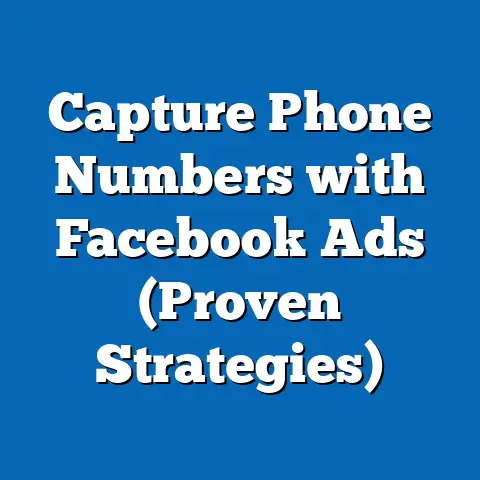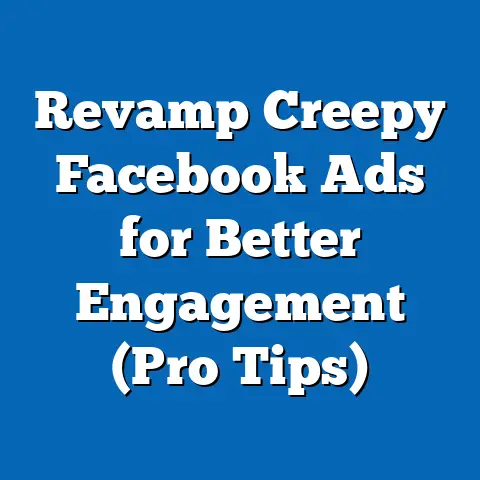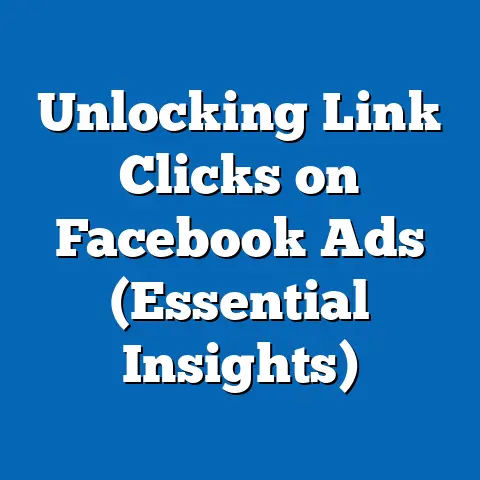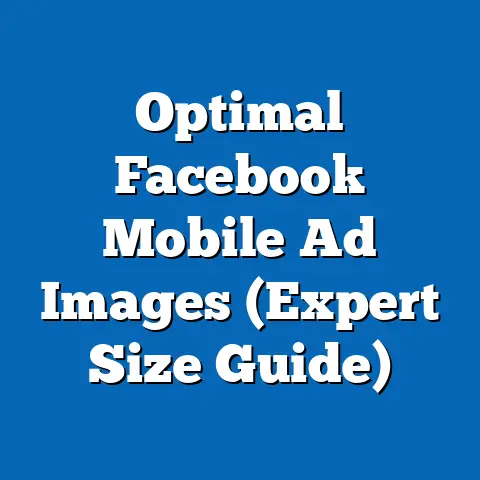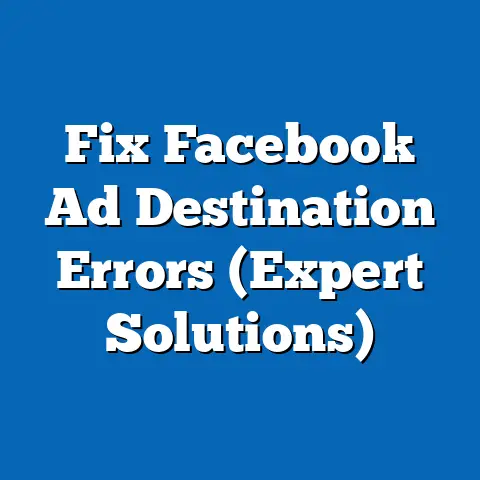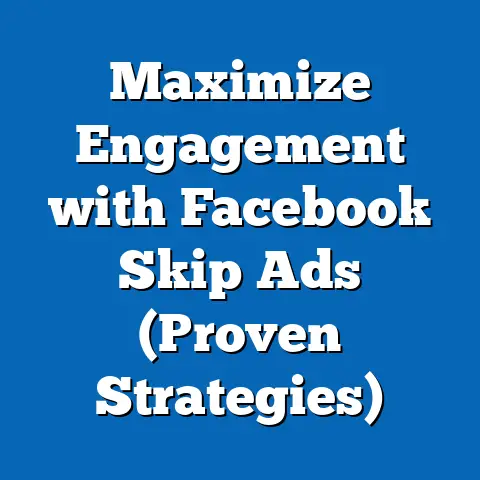Boost Facebook Ad Likes Today (Proven Strategies)
I remember the first time I launched a Facebook ad campaign. I was so excited, meticulously crafting the perfect copy and selecting what I thought were stunning visuals. I hit “publish” and waited, brimming with anticipation. The results? Crickets. A few impressions, even fewer clicks, and a disheartening lack of likes. It was a humbling experience, but it sparked a deep dive into understanding what truly makes a Facebook ad resonate with an audience.
Today, Facebook remains a powerhouse in the digital marketing landscape. Reaching over 2.8 billion monthly active users, it offers unparalleled opportunities for businesses of all sizes. But with so much noise, getting your ads noticed – and, more importantly, liked – is a constant challenge. It’s not just about vanity; likes are a crucial indicator of engagement, social proof, and ultimately, ad performance. A higher engagement rate can lead to better ad rankings, lower costs, and a wider reach.
The objective of this article is simple: to equip you with proven strategies to boost likes on your Facebook ads. We’ll go beyond the basic tips and delve into actionable techniques, backed by data and real-world examples, that will transform your ads from unnoticed to irresistible. Get ready to turn those thumbs up into a powerful force for your business.
Section 1: Understanding Your Audience
Imagine trying to sell snowshoes to someone living in the Sahara Desert. Sounds ridiculous, right? Yet, many businesses make a similar mistake by failing to truly understand their target audience on Facebook. You can’t just throw an ad out there and hope for the best. You need to know who you’re talking to, what they care about, and what motivates them.
Identifying Your Target Audience
Facebook offers a wealth of targeting options, allowing you to segment and reach specific demographics with laser precision. But where do you start?
- Facebook Audience Insights: This free tool is a goldmine of information. By inputting your existing customer data or selecting broad demographics, you can uncover valuable insights into their interests, behaviors, education levels, relationship statuses, and even the pages they like. I’ve personally used Audience Insights to discover unexpected interests shared by my target audience, allowing me to refine my targeting and create more relevant ads.
- Lookalike Audiences: If you have a strong customer base, leverage Facebook’s Lookalike Audiences. This feature allows you to create new audiences that share similar characteristics to your existing customers, significantly expanding your reach while maintaining relevance.
- Website Custom Audiences: Install the Facebook Pixel on your website (more on that later) to track user behavior and create custom audiences based on website visits, specific page views, or actions taken. This is a powerful way to retarget users who have already shown interest in your products or services.
Creating Buyer Personas
Beyond demographics, creating detailed buyer personas is crucial for understanding your audience on a deeper level. A buyer persona is a semi-fictional representation of your ideal customer, based on research and data about your existing and potential customers.
Include the following elements in your buyer personas:
- Demographics: Age, gender, location, income, education, job title
- Psychographics: Interests, values, lifestyle, personality traits
- Goals and Motivations: What are they trying to achieve? What drives them?
- Pain Points and Challenges: What are their biggest frustrations? What obstacles are they facing?
- Facebook Usage: How often do they use Facebook? What types of content do they engage with? What pages do they follow?
For example, let’s say you’re selling organic skincare products. Your buyer persona might look like this:
- Name: Sarah
- Age: 35
- Location: San Francisco, CA
- Occupation: Marketing Manager
- Interests: Yoga, healthy eating, environmental sustainability, natural beauty products
- Goals: To maintain healthy, glowing skin using natural and ethical products.
- Pain Points: Overwhelmed by the number of skincare products on the market, concerned about harmful chemicals in traditional skincare, looking for affordable and effective organic options.
- Facebook Usage: Checks Facebook daily, follows several organic skincare brands, engages with content related to healthy living and environmental issues.
Tailoring Content to Audience Needs
Once you have a clear understanding of your target audience and their needs, you can tailor your ad messaging and visuals to resonate with them on a deeper level.
- Speak Their Language: Use the same language and tone as your target audience. Avoid jargon or overly technical terms.
- Address Their Pain Points: Highlight how your product or service solves their specific problems and makes their lives easier.
- Showcase the Benefits: Focus on the benefits of your product or service, rather than just the features. How will it improve their lives?
- Use Relevant Visuals: Choose images and videos that are visually appealing and relevant to your target audience. Use people who represent your target audience in your ads.
Remember Sarah, the organic skincare enthusiast? Instead of a generic ad showcasing all your products, you could create an ad specifically targeting her, highlighting your organic ingredients, ethical sourcing, and the benefits of natural skincare for sensitive skin.
Takeaway: Understanding your audience is the foundation of successful Facebook advertising. Use Facebook Audience Insights, create detailed buyer personas, and tailor your ad content to resonate with their specific needs and interests.
Section 2: Crafting Compelling Ad Content
Now that you know who you’re talking to, it’s time to craft ad content that grabs their attention and compels them to take action. In today’s fast-paced digital world, you have mere seconds to make an impression. Your ad needs to be visually appealing, engaging, and relevant to your target audience.
Writing Engaging Copy
The words you use in your Facebook ad are just as important as the visuals. Your ad copy should be clear, concise, and compelling, capturing the attention of your target audience and motivating them to learn more.
- Headline: Your headline is the first thing people will see, so make it count. Use strong verbs, create a sense of urgency, or ask a question that piques their curiosity. Examples:
- “Unlock Your Dream Skin with Our Organic Skincare”
- “Limited Time Offer: 50% Off All Organic Products”
- “Are You Tired of Harsh Chemicals in Your Skincare?”
- Body Copy: Your body copy should expand on your headline and provide more details about your product or service. Focus on the benefits, not just the features. Use storytelling to connect with your audience on an emotional level. Keep it short and sweet.
- Call to Action (CTA): Your CTA tells people what you want them to do next. Use clear and concise language, such as “Shop Now,” “Learn More,” “Sign Up Today,” or “Get Your Free Trial.” Make sure your CTA is visually prominent and easy to click.
- “Unlock Your Dream Skin with Our Organic Skincare”
- “Limited Time Offer: 50% Off All Organic Products”
- “Are You Tired of Harsh Chemicals in Your Skincare?”
I once ran a campaign for a local coffee shop. Instead of just saying “Best Coffee in Town,” we crafted a story around the experience: “Imagine waking up to the aroma of freshly roasted beans, the warmth of a perfectly brewed latte in your hands. Start your day right at [Coffee Shop Name].” This resonated with our target audience and led to a significant increase in foot traffic.
Visual Elements
High-quality images and videos are essential for capturing attention on Facebook. People are visually driven, and a compelling visual can make all the difference in whether someone stops scrolling and engages with your ad.
- High-Resolution Images: Use images that are clear, crisp, and visually appealing. Avoid blurry or pixelated images.
- Relevant Images: Choose images that are relevant to your product or service and resonate with your target audience. Use people who represent your target audience in your ads.
- Eye-Catching Videos: Videos are incredibly engaging on Facebook. Use short, attention-grabbing videos that showcase your product or service in action. Consider using captions to make your videos accessible to viewers who have their sound turned off.
- Mobile-Friendly Visuals: Remember that most Facebook users are on mobile devices. Optimize your visuals for mobile viewing by using vertical videos and ensuring that your images look good on smaller screens.
A personal example: I was working with a travel company promoting a hiking tour in the Swiss Alps. Instead of using generic stock photos, we hired a local photographer to capture stunning images of the actual hiking trails and the breathtaking scenery. The response was incredible. People were captivated by the authentic visuals and eager to book the tour.
A/B Testing
A/B testing, also known as split testing, is the process of comparing two versions of an ad to see which one performs better. This is a crucial step in refining your ad content for maximum engagement.
- Test Different Elements: A/B test different elements of your ad, such as the headline, body copy, visuals, CTA, and targeting options.
- Test One Element at a Time: To accurately measure the impact of each element, test only one element at a time.
- Use Facebook’s A/B Testing Tool: Facebook provides a built-in A/B testing tool that makes it easy to create and track your tests.
- Analyze the Results: Carefully analyze the results of your A/B tests to identify which version of your ad performs better. Use this data to optimize your future ads.
I once ran an A/B test on a Facebook ad for an online course. Version A used a headline that focused on the benefits of the course (“Learn New Skills and Advance Your Career”), while Version B used a headline that created a sense of urgency (“Limited Spots Available: Enroll in Our Course Today”). Version B significantly outperformed Version A, demonstrating the power of urgency in driving conversions.
Takeaway: Crafting compelling ad content is a combination of art and science. Write engaging copy, use high-quality visuals, and continuously A/B test your ads to optimize for maximum engagement.
Section 3: Leveraging Facebook Features
Facebook offers a suite of powerful features that can significantly enhance your ad performance and boost likes. These features allow you to track user behavior, retarget ads effectively, and engage with your audience in meaningful ways.
Utilizing Facebook Pixel
The Facebook Pixel is a small snippet of code that you install on your website. It allows you to track user behavior on your website after they click on your Facebook ad. This data can be used to:
- Retarget Ads: Show ads to people who have visited your website or taken specific actions, such as adding items to their cart but not completing the purchase.
- Create Custom Audiences: Build custom audiences based on website visits, page views, or actions taken.
- Optimize Ads for Conversions: Optimize your ads for specific conversion events, such as purchases, leads, or sign-ups.
- Measure Ad Performance: Track the effectiveness of your ads by measuring the number of conversions they generate.
I’ve seen firsthand the power of the Facebook Pixel. By retargeting website visitors who abandoned their shopping carts, I was able to recover a significant percentage of lost sales for an e-commerce client.
Engaging with Comments
Engaging with users who comment on your ads is crucial for fostering a community and boosting likes. Responding to comments shows that you care about your audience and that you’re willing to engage in a conversation.
- Respond Promptly: Respond to comments as quickly as possible.
- Be Positive and Helpful: Provide helpful and informative responses to questions and address any concerns.
- Encourage Discussion: Ask questions to encourage further discussion and engagement.
- Moderate Comments: Remove any inappropriate or offensive comments.
I remember a time when a user left a negative comment on one of my client’s Facebook ads. Instead of ignoring the comment, I responded promptly, acknowledged their concerns, and offered a solution. The user was impressed by our responsiveness and ended up becoming a loyal customer.
Using Facebook Stories and Reels
Facebook Stories and Reels are newer features that offer unique opportunities to enhance visibility and engagement.
- Facebook Stories: Short, vertical videos or images that disappear after 24 hours. Use Stories to share behind-the-scenes content, announce promotions, or run polls and quizzes.
- Facebook Reels: Short, entertaining videos that can be shared with a wider audience. Use Reels to showcase your products in creative ways, share tutorials, or participate in trending challenges.
I’ve found that using Facebook Stories and Reels can be a great way to reach a younger audience and generate buzz around your brand. I once created a series of Reels showcasing the different ways to use a client’s product, and the response was phenomenal. We saw a significant increase in engagement and website traffic.
Takeaway: Facebook offers a range of features that can help you optimize your ads, track user behavior, and engage with your audience. Utilize the Facebook Pixel, engage with comments, and explore the potential of Facebook Stories and Reels to boost likes and overall ad performance.
Section 4: Timing and Frequency
The timing and frequency of your Facebook ads can have a significant impact on their performance. You need to make sure you’re showing your ads to the right people at the right time, without overwhelming them with too many ads.
Optimal Posting Times
Analyzing data on when your target audience is most active on Facebook can help you determine the optimal posting times for your ads.
- Facebook Page Insights: Use Facebook Page Insights to see when your followers are most active.
- Third-Party Tools: Use third-party tools to analyze broader Facebook usage data and identify peak engagement times.
- A/B Testing: A/B test different posting times to see which ones generate the best results.
I’ve found that posting ads in the evening and on weekends tends to generate higher engagement, as people are more likely to be browsing Facebook during their leisure time. However, the optimal posting times can vary depending on your target audience and industry.
Ad Frequency Management
Ad frequency refers to the number of times a user sees your ad. It’s important to manage ad frequency to avoid ad fatigue and ensure continued engagement.
- Monitor Frequency Metrics: Keep a close eye on your ad frequency metrics in Facebook Ads Manager.
- Frequency Cap: Set a frequency cap to limit the number of times a user sees your ad within a certain time period.
- Rotate Ads: Rotate your ads regularly to keep them fresh and engaging.
- Target Different Audiences: Target different audiences with different ads to avoid overwhelming any one group of users.
I once ran a campaign where the ad frequency got out of control. Users were seeing the same ad multiple times a day, and the engagement rate plummeted. By implementing a frequency cap and rotating the ads, I was able to reduce ad fatigue and improve performance.
Takeaway: Timing and frequency are crucial elements of successful Facebook advertising. Analyze your audience data to determine the optimal posting times and manage ad frequency to avoid ad fatigue and maximize engagement.
Section 5: Social Proof and User-Generated Content
People are more likely to trust and engage with brands that have a strong social presence and positive reviews. Social proof, in the form of testimonials, reviews, and user-generated content, can significantly enhance your credibility and attract more likes on your Facebook ads.
The Role of Testimonials and Reviews
Incorporating testimonials and reviews into your ads can be a powerful way to build trust and credibility.
- Highlight Positive Reviews: Showcase positive reviews from satisfied customers in your ad copy or visuals.
- Use Video Testimonials: Video testimonials are even more engaging than written reviews.
- Feature Influencer Reviews: If you’ve partnered with influencers, feature their reviews in your ads.
I once worked with a restaurant that had a 5-star rating on Yelp. We created a Facebook ad featuring a quote from a glowing Yelp review, and the response was fantastic. People were eager to try the restaurant based on the positive feedback from other customers.
Encouraging User-Generated Content
Encouraging customers to share their experiences and tag your brand can create organic engagement and boost likes.
- Run Contests and Giveaways: Encourage users to share photos or videos of themselves using your product for a chance to win a prize.
- Ask for Reviews: Actively solicit reviews from satisfied customers.
- Create a Branded Hashtag: Encourage users to use your branded hashtag when sharing content related to your brand.
- Feature User-Generated Content: Feature user-generated content on your Facebook page and in your ads.
A clothing brand I worked with launched a campaign encouraging customers to share photos of themselves wearing their clothes using a branded hashtag. They then featured the best photos on their Facebook page and in their ads. This generated a ton of engagement and helped to build a strong sense of community around the brand.
Takeaway: Social proof and user-generated content are powerful tools for building trust, credibility, and engagement on Facebook. Incorporate testimonials and reviews into your ads and encourage customers to share their experiences and tag your brand.
Section 6: Collaborations and Influencer Marketing
Collaborating with other businesses and influencers can expand your reach and attract likes from their followers.
Partnering with Influencers
Influencer marketing involves partnering with individuals who have a large and engaged following on social media.
- Identify Relevant Influencers: Find influencers whose audience aligns with your target audience.
- Reach Out and Build Relationships: Contact influencers and build genuine relationships with them.
- Collaborate on Content: Work with influencers to create engaging content that promotes your brand.
- Track Results: Track the results of your influencer marketing campaigns to measure their effectiveness.
I’ve seen influencer marketing work wonders for brands in various industries. By partnering with the right influencers, you can reach a wider audience, build trust, and generate a significant amount of engagement.
Co-Branding Opportunities
Co-branding involves partnering with another business to create a joint marketing campaign.
- Find Complementary Businesses: Look for businesses that offer complementary products or services to yours.
- Create a Joint Offer: Create a special offer that benefits both businesses.
- Cross-Promote Each Other: Cross-promote each other’s products or services on your respective Facebook pages and in your ads.
A local bakery I worked with partnered with a coffee shop to offer a “Pastry and Coffee Combo” deal. They cross-promoted the deal on their Facebook pages and in their ads, and it was a huge success. Both businesses saw an increase in sales and engagement.
Takeaway: Collaborations and influencer marketing can be a great way to expand your reach, build trust, and attract likes from new audiences. Partner with relevant influencers and explore co-branding opportunities to boost your Facebook ad performance.
Conclusion
Boosting likes on your Facebook ads is not just about vanity; it’s about building engagement, social proof, and ultimately, driving results for your business. By understanding your audience, crafting compelling ad content, leveraging Facebook features, optimizing your timing and frequency, incorporating social proof and user-generated content, and collaborating with influencers, you can transform your ads from unnoticed to irresistible.
Remember, a holistic approach is key. It’s not enough to just focus on one strategy. You need to combine audience understanding, compelling content, and leveraging Facebook features to create a truly effective ad campaign.
Now it’s your turn. Implement these strategies in your next Facebook ad campaign and watch your likes – and overall engagement – grow. Don’t be afraid to experiment, test different approaches, and learn from your results. With consistent effort and a data-driven approach, you can unlock the full potential of Facebook advertising and achieve your business goals. So, go ahead, start creating ads that people love to like!

